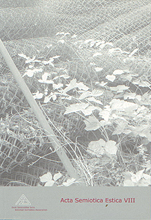Eesti imemuinasjuttude alguse- ja lõpuvormelitest
On beginning and ending formulas of Estonian tales of magic
Author(s): Kristin VaikSubject(s): Semiotics / Semiology
Published by: Eesti Semiootika Selts
Keywords: cultural semiotics; tales of magic; frame theory; fictional worlds; kultuurisemiootika; imemuinasjutud; alguse- ja lõpuvormelid; raamiteooria; fiktsionaalsed maailmad
Summary/Abstract: In this article the beginning and ending formulas of Estonian tales of magic (tale types 300–749 in ATU catalogue) are examined. The aim of the article is firstly to draw from the theoretical part the main functions of the beginning and ending formulas of the tales of magic and secondly to analyse the typical beginning and ending formulas of the Estonian tales of magic and explain their functioning. To achieve the first goal, folklorists’ descriptions of the formulas are explored and analysed from a semiotical perspective, making use of the relevant aspects of cultural semiotics (Juri Lotman), the frame theory of narratology (Katharine Galloway Young) and the theory of literary fictional worlds (Ludomir Doležel). As a result the beginning and ending formulas are viewed as guiding frames between Storyrealm and Taleworld, which lead listeners to the Taleworld and back, letting them know that what is beginning or ending is or was a tale of magic, and notifying them, in the case of beginning formulas, that for the appreciation of what follows a peculiar state of mind effected by a "voluntary suspension of disbelief" (see Dégh 1981) is necessary. In the second part of the article, typical beginning and ending formulas of Estonian tales of magic are analysed based on their lexicon, keeping in mind their main functions. As a consequence the meaning and functions of typical formulas are revealed in a cognitive perspective.
Journal: Acta Semiotica Estica
- Issue Year: 2011
- Issue No: 8
- Page Range: 151-169
- Page Count: 19
- Language: Estonian

